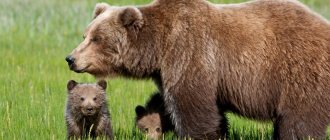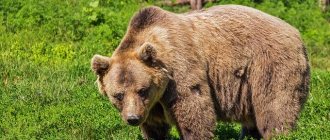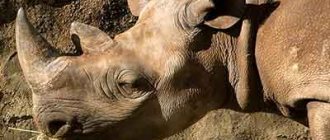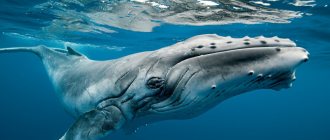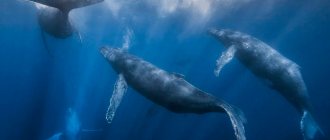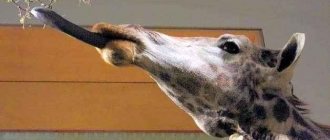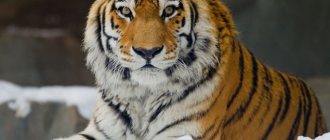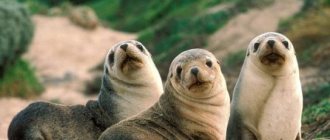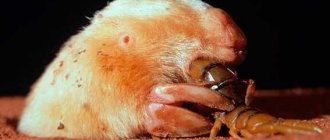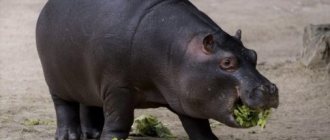Mammals are considered one of the most independent and organized animals. They have a well-developed nervous system, feed their offspring with their milk, their warm-bloodedness has enabled them to spread widely throughout the planet and live in different places, thanks to which an impressive list can be made of their families, genera and species. A description of mammals can only be given in general terms - they are so diverse and different from each other. The overwhelming majority inhabit forests, mountains, as well as oceans and seas.
Origin of mammals
Andrewsarchus - the predatory ancestor of mammals
All mammals have common ancestors. They belong to the class of animal-toothed reptiles. Such conclusions were made due to the similar structure of the jaws and placement of teeth. Over time, some animals became a separate category. They were smaller, similar in appearance to oviparous ones. There was a gradual development of the brain and muscle systems, due to which animals began to build more complex lines of behavior.
Rodents
Spiny mouse
The largest order of mammals, consisting of more than 2,000 species, includes squirrels, dormice, mice, rats, gerbils, beavers, ground squirrels, kangaroo hoppers, porcupines, striders and many others. All these tiny, furry animals have teeth: one pair of incisors in the upper and lower jaws? and a large gap (called a diastema) located between the incisors and molars. Rodents' incisors grow continuously and are constantly used to grind food.
Features and Signs
In terms of body structure and internal systems, mammals are similar to each other. They have quite large brains and complex behavior patterns. Such animals take care of their offspring and feed them milk. Gradually they adapted to different conditions, so there are many representatives of this class.
Mammals can be recognized by the following features and characteristics:
- Large eyes are characteristic of night hunters.
- The body is covered with wool, which perfectly retains heat.
- Mammalian tails vary in shape and length. This part of the body helps maintain balance.
- There are special glands for producing milk and feeding offspring.
Caguanas
Malayan woolwing
Never heard of kaguans? And this is possible, because on our planet there are only two living species of woolly wings left, which live in the dense jungles of Southeast Asia. Caguans have a wide membrane of skin that connects all the limbs, tail and neck, which allows them to glide from one tree to another, a distance of about 60 m.
Oddly enough, molecular analysis has demonstrated that caguans are the closest living relatives of our own order of mammals, the primates, but their parenting behavior is most similar to marsupials!
External structure
The structure of a mammal using the example of a dog
Mammals are similar to each other in body structure. You can always distinguish two pairs of limbs, head, neck, torso. The first has a complex shape, divided into cranial and facial sections. A special feature is the outer ears - only mammals have such a change.
On the skin you can find hair follicles that cover the entire body. Additionally, there are glands divided into sweat, fat, and milk glands. Most mammals live on land, so their limbs are located below the body. Thanks to this, it is easier for them to move on solid ground.
Lagomorpha
Hare
Even after centuries of study, scientists are still not sure what to do with hares, rabbits and pikas. These small mammals are similar to rodents, but have some important differences: lagomorphs have four, rather than two, incisors in the upper jaw, and are strict vegetarians, whereas mice, rats and other rodents tend to be omnivores.
Lagomorphs can be identified by their short tails, long ears, slit-like nostrils that they can close, and (in some species) a strong tendency to move around by jumping.
Internal structure
The internal structure of mammals using the example of a cat
The internal structure of mammals is quite complex. Organs are divided into separate systems, each of which performs a number of tasks important for the survival of the body. They differ in structure, location, and individual characteristics.
Musculoskeletal system
All mammals are vertebrates. The skull is larger than that of other animals due to a developed and enlarged brain. Their spine is divided into five sections. The internal organs of mammals are reliably protected by the chest. The sacrum fits neatly into the pelvic bones. Together with the muscles, the skeleton forms the musculoskeletal system. It is quite developed, making it possible to make complex movements.
Respiratory system
During the process of evolution, mammals developed a diaphragm. This is a special partition that separates the organs of the respiratory system from the abdominal cavity. This structure helps to vary the volume of the chest, depending on the situation and general muscle load.
Circulatory system
The circulatory system of mammals is complex. It represents two independent circles of blood movement throughout the body, a heart with four working chambers. Thus, metabolism is significantly accelerated.
Digestive system
The structure of the digestive system of mammals is quite complex. What stands out here is a well-developed liver, intestines, the length of which varies depending on the animal’s diet, and stomach. Each representative has an oral cavity where food is ground with the help of teeth and broken down by saliva. This process continues in the stomach with the help of special bacteria and juices.
Excretory system
The excretory system consists of the kidneys, which produce fluid, the bladder, and the intestines. Mammals can leave secretions in any weather. Waste contains undigested food debris with a minimal amount of useful substances that the animal’s body could not obtain.
Nervous system
The nervous system of mammals is quite developed compared to other classes. The brain has enlarged hemispheres. Thus, mammals exhibit complex behavioral patterns. Some animals have elements of reason; they can analyze situations, express emotions, and communicate with other species. Each representative of the species has its own degree of development.
Pangolins
Steppe lizard
Also known as pangolins, pangolins have large, horny, diamond-shaped scales (made of keratin, the same protein as human hair) that overlap and cover their bodies. When these creatures are threatened by predators, they curl into tight balls, and if they feel threatened, they emit a foul-smelling liquid from their anal glands. Pangolins are native to Africa and Asia, and are almost never found in the Western Hemisphere except in zoos.
Dimensions
Sizes of Mammals
The sizes of mammals vary widely. The smallest representative of the class is the dwarf shrew: up to 4.5 mm. And the savannah elephant is considered the largest - up to 4 m.
The most massive representatives can exceed several tons in weight. It is easier for them to endure difficult climatic conditions and protect themselves from natural enemies. According to scientists, the increase in body weight is explained by evolutionary changes that helped mammals survive using simpler methods.
Cetaceans
Dolphin
Cetaceans are an order of almost a hundred species and are divided into two main suborders: toothed whales (including sperm whales, beaked whales, killer whales, as well as dolphins and porpoises) and baleen whales (smooth, gray, dwarf and striped whales).
These mammals are characterized by their flipper-like forelimbs, reduced hind limbs, streamlined bodies, and a massive head that extends into a “beak.” Cetacean blood is unusually rich in hemoglobin, and this adaptation allows them to remain underwater for long periods of time.
Reproduction
Mammals can only reproduce sexually. Almost all of them carry their babies using the placental method. Born animals are quite developed at the time of birth. An exception to this rule are marsupials and oviparous representatives of the class.
Interesting: Why are cats afraid of cucumbers? Reasons, photos and videos
Almost all mammals are polygamous, which contributes to the diversity of offspring, the ability to produce a large number of young in a short period. Only about 3% of all species are monogamous.
The general process of reproduction and the number of cubs during a given period depend on the habitat. The available food has a direct influence, since females take care of their offspring until they grow up.
Hyraxes
Bruce's hyrax
Hyraxes are plump, short-legged, herbivorous mammals that look a bit like a cross between a domestic cat and a rabbit. There are four (according to some sources five) species of hyraxes: tree hyrax, western hyrax, Cape hyrax and Bruce hyrax, all of which are native to Africa and the Middle East.
One of the strangest features of hyraxes is their relative lack of internal temperature regulation; They are warm-blooded, like all mammals, but at night they gather in groups to keep warm, and during the day they warm up in the sun for a long time, like reptiles.
What do they eat
Mammals eat a wide variety of foods, each species has a specific diet.
Many members of the mammal class have teeth for eating food. Only a few of them have lost such elements in the process of evolution. Animals live in a variety of environments, differ in size and individual structural features, so their food is varied.
Marine representatives can eat algae, other mammals, and small fish. Terrestrials are divided into those who eat plant foods, other animals and omnivores. Depending on food preferences and natural enemies, each representative is assigned to a specific position in the food chain.
Primates
Pygmy marmoset
The order Primates includes about 400 species and in many ways its representatives can be considered the most “advanced” mammals on the planet, especially with regard to the size of their brains. Non-human primates often form complex social units and are capable of tool use, and some species have dexterous hands and prehensile tails. There is no single feature that defines all primates as a group, but these mammals share common features such as binocular vision, hair, five-fingered limbs, fingernails, developed cerebral hemispheres, etc.
Groups of mammals
Scientists divide mammals into several groups, depending on the individual characteristics of embryonic development. Among them:
- Oviparous . The most primitive breeding option. Representatives lay eggs to breed offspring.
- Marsupials . The birth of live young occurs after a very short period of gestation. The offspring are not developed and cannot independently take care of their survival. Development occurs in the female's pouch.
- Placental . They have a fairly long gestation period. Cubs are less exposed to the dangers of the environment, but also depend on breastfeeding during the first period of life.
Jumpers
Short-eared jumper
Hoppers are small, long-nosed, insectivorous mammals native to Africa. Currently, there are about 16 species of jumpers, which are grouped into 4 genera, such as: proboscis blennies, forest jumpers, long-eared jumpers and short-eared jumpers. The classification of these small mammals has been the subject of debate; in the past they were presented as close relatives of ungulate mammals, lagomorphs, insectivores and tree shrews (recent molecular evidence suggests a relationship with elephants).
Mammal species
According to experts, today there are more than 5,000 species of animals belonging to the class of mammals. The list also includes a person. During the process of evolutionary changes, more than 20,000 species of representatives of this class disappeared. Mammals vary in many ways, and their sizes vary widely, from very small to truly enormous.
Rodents
The most common order of mammals is rodents. They are distinguished by the peculiarity of the structure of their teeth - there are a pair of rather large incisors. Their numbers account for more than 40% of all mammal species existing today.
Squirrel
Squirrel
Squirrels are small rodents whose body length is no more than half a meter. They live in parks, forests, and on almost all continents. They establish a permanent place of residence in tree hollows. Squirrels are omnivorous rodents, but they prefer a variety of plant foods.
Interesting fact : squirrels are thrifty. They make a lot of food caches, but often forget about them. Thanks to this, many new trees sprout every year.
Chipmunk
Chipmunk
Chipmunks are squirrel-like mammals. Their body sizes vary within a small range - from 5 to 15 cm. At the same time, the tail can be from 7 to 12 cm. In total, there are 25 species of mammals that belong to chipmunks. The animal lives in wooded areas, but can run into fields in search of food. Prefers plant food, sometimes swallowing it along with insects.
Gopher
Gophers
are also small rodents. Their body length does not exceed 40 cm. The tail usually occupies no more than 40% of the body. These representatives of mammals live in fields and meadows, so people often come into contact with them. Gophers dig holes for themselves as a home. They feed on plants located nearby. Small insects are often added to the diet.
Marmot
Marmots
are common mammals that can be found on almost all continents. Depending on the species, they prefer meadows or mountains for residence. Thanks to their fur, animals can easily withstand harsh conditions. Marmots are omnivores, so there are no problems finding food. In most cases, they select different parts of plants to eat. If an insect falls into the paws of a marmot, he will happily eat it.
Hamster
Hamster
Hamsters have become popular pet rodents. In their natural environment they live in fields and forests. They live alone, creating quite complex systems of burrows underground. Body sizes can vary from 5 to 34 cm. In most species, the female is larger than the male. Hamsters eat plant foods. They have special cheek pouches in which they easily store food.
Mouse
Mouse
Mice are common rodents, as they are found almost everywhere except Antarctica. Their body sizes can vary from 5 to 48 cm, depending on the species. They live in forests, fields, meadows, and near human habitations in order to find food. Mice are omnivores, including eating a variety of thermally processed foods. Most often, they are active at night, their eyes and sensory organs are adapted to move quickly in the dark.
Rat
Rat
Rats are common mammals that have adapted to numerous environments on different continents. They use fields, forests, meadows as places to live, as well as places near people - basements, outbuildings. Rats choose both self-made holes and other people's shelters. The body length of such a rodent can vary from 7 to 30 cm. These animals are omnivores, although they prefer plant foods.
Interesting: The most affectionate cat breeds - list, name, description, photo and video
Lagomorpha
Some families of mammals are lagomorphs. They differ from rodents by having two pairs of incisors. One of them is more developed, the other is located behind, has a small size and bite force.
Hare
Hare
Hares have a developed musculoskeletal system. Given the small size of the animal, its speed can reach 70 km/h. For living he chooses fields and mixed forests. Often lives alone or in pairs. Hares create nests in small, hidden holes. They eat only plant foods.
Rabbit
Rabbit
Rabbits are less developed than hares. They live in sheltered burrows, since their offspring are weaker at birth - the cubs are blind and completely helpless. Adults range in size from 20-50 cm and have powerful hind legs for fast movement. Rabbits live in fields, meadows and mixed forests. They eat plant foods.
Pika
Pika
differ from other representatives of lagomorphs by an extensive set of sounds with the help of which they communicate with each other. The body length of pikas is small - about 20 cm, the tail is practically absent. The animals live in burrows, making a complex system of passages. A variety of plants are eaten.
Interesting fact : pikas store hay for the winter, which is why they got the second name for hay storage.
Insectivores
Insectivores constitute a separate order of mammals, most of whose species have now disappeared. A distinctive feature is the absence of the cecum in all representatives.
Hedgehog
Hedgehog Hedgehogs
have small body sizes - reaching no more than 25 cm. The tail grows - up to 3 cm. The animals choose small edges, parks, forests, meadows and fields, places near water bodies for living. Hedgehogs are omnivores, but more often they eat insects, slugs and even mice, eggs, and other small mammals.
Interesting fact : baby hedgehogs feed on milk, while it is strictly forbidden for adults, as it stops being digested.
Mole
Mole
Moles have average body sizes - from 9 to 20 cm. They prefer to choose damp places to live, meadows, and shaded areas of the steppes. They live underground almost all the time, so their vision is very weak, unlike their sense of smell. They quickly create complex systems of burrows in which they orient themselves perfectly. Moles feed on small insects and rarely on other mammals.
Muskrat
Muskrat
The muskrat is a relict animal, so all its body systems are less developed than those of other members of the family. The size of the animal is about 20 cm. The body is covered with scales mixed with hair, the tail is small. For living, muskrats choose a variety of bodies of water. They feed on insects, small fish and crustaceans.
Shrew
Shrew
Small representatives of the family, the total number of species today is about 70. They have a body size of up to 9 cm. They live in meadows and reservoirs. They make small holes for themselves. They feed on small insects. They can also approach a person’s house in search of grain crops.
Chiroptera
One of the representatives of mammals, the number of species of which is second in number, after rodents. They are distinguished by their ability to fly for long periods of time. Additionally, they have echolocation, so they have poor vision.
Bat
Bat
Almost all bats are united under this name. Bats are small in size - up to 10 cm, and are nocturnal. For living they choose caves, forests, darkened grottoes, and utility rooms. They have a very active metabolism, so their diet contains a large number of insects. They can go without food for a long time.
Predatory
A order of mammals that contains a large number of families. It is divided into additional orders of canines and felines. Placental animals, most of which are carnivores.
a lion
Leo
One of the representatives of the big cat family. There are pronounced differences between females and males. The latter are larger, stronger, and have a thick mane. They live in fields and steppes in flocks where there is a clear leader. They feed on small animals, can track their prey for a long time, hunt in a pack, dividing the caught prey, according to the status of each lion.
Wolf
Wolf
Predatory representatives of the family, belong to the canine family. They have a height of up to 90 cm at the withers. They live on the territory of steppes and forests. Most often, they form flocks, dividing territories and hunting grounds between them. Wolves are carnivores, so they feed on a variety of animals, including small mammals. They prefer to hunt in packs.
Fox
Fox
Foxes have small body sizes - from 60 to 90 cm, as well as surprisingly large tails, which can account for 70% of the total length of the animal. They are distinguished by their elongated snout and live in independently created burrows in forests, fields, and meadows. They hunt at night and prefer to be secluded from other members of the family.
Bear
Bears
live almost everywhere. Representatives of some species grow up to two meters, their weight can exceed several centners. Such a large animal lives in forest thickets, mountains, and rarely gets close to humans. Bears feed on a variety of animals, plants, and small insects. They hibernate during the winter to conserve energy in difficult climatic conditions.
Interesting fact : sometimes bears may not sleep for the winter. They remain half-conscious. Such animals are dangerous because they are hungry and do not always realize where they are.
Lynx
Lynx
Lynx belongs to the cat family. Its dimensions rarely exceed one meter. In addition to strong front legs, larger body sizes, they are very similar to domestic cats. They live in forests and mountains and easily tolerate difficult climatic conditions. They hunt a variety of animals, including large representatives of mammals. They prefer to live independently.
Interesting: Why do cats climb trees but dogs don’t? Description, photo
Weasel
Weasel
One of the smallest representatives of mammals from the order of predators. The body length of an adult male does not exceed 25 cm. They live near bodies of water, creating small burrows or nests in recesses. Weasels feed preferably on fish, small crustaceans, and various insects. They live alone or in couples.
Dog
Dog
A domestic animal that has many species, including artificially created ones. Length and height vary considerably, depending on the species. Lives with a person. Preferred feeding varies by species. It should consist of fresh meat, a variety of vegetables and vitamins.
Cat
Cat
A domestic animal whose size is no more than 90 cm. Known for its variety of species, some created by man. The appearance of different breeds differs significantly in color, thickness of fur, and characteristic behavioral features. Cats eat fresh meat, offal, and a variety of vegetables.
Odd-toed ungulates
They belong to mammals whose feet have an unpaired number of toes that form hooves. They are exclusively herbivores, so they feed on a wide variety of plants.
Horse
Horse
Usually the height of a horse does not exceed two meters. In artificially bred breeds, larger representatives can be observed. There are wild and domestic horses. They feed on a variety of herbs, vegetables and fruits. Wild representatives live in meadows and steppes. They are shy and can move quickly at a gallop.
Rhinoceros
Rhinoceros
Distributed throughout Asia and Africa. A distinctive feature is the horn located on the nose. A massive animal whose weight can exceed several tons. Prefers to live in steppes where there are bodies of water nearby. Rhinos often form small groups for protection. They feed on grasses and grains.
Zebra
Zebra
is part of the equid family and is distinguished by its unusual color - white and black stripes that alternate throughout the body. They are small in size - up to 1.3 meters in height. Despite the bright color, they hide even in open areas. Zebras often form flocks because they are vulnerable to a variety of predators.
Fun fact : Each zebra has unique black and white stripes. Thanks to them, scientists can track a specific individual.
Tapir
The tapir
differs from other representatives of equids by its unusual appearance. From the outside, it looks more like a pig than other members of the family. It has an unusual long trunk adapted for eating food. The tapir lives in grasslands, steppes and savannas. Prefers a solitary lifestyle.
Artiodactyls
Representatives of mammals that have developed fourth toes that form the hooves. Today there are about 200 species.
Boars and pigs
boar
Wild boars and domestic pigs measure up to two meters and weigh several centners. In their natural environment, representatives of the family live in steppes and forests, most often alone. They feed on a variety of insects and plants. Pigs are important to agriculture and are raised on numerous farms.
Deer
Deer
The size of deer varies within two meters. There is a significant difference between females and males. The latter have massive horns that continue to grow throughout their lives. They can live in pairs or flocks; males fight during the mating season. Deer are completely herbivores. They live in forests and mountains.
Interesting fact : during fights, deer often break their antlers and get entangled with their opponents.
Ram
The ram
is small in height - up to 1.8 meters, weight varies from 20 to 200 kg, depending on the species. In the natural environment, representatives of the family live in meadows and fields, mountains. Thanks to their fur they can withstand adverse conditions. Sheep eat exclusively grasses and plants.
Elk
Elk
differs from deer in having solid, flat antlers in males and long thick hair. Can reach two meters in height. Lives in flocks or pairs. The habitats were forests, fields, steppes and mountains. Feeds on plant foods.
Roe
Roe deer
Lives in Eurasia, can be found in forests or bush areas. Rarely climbs mountains to survive harsh winters. Prefers living in small groups and flocks. Roe deer are herbivorous representatives of mammals.
Giraffe
The giraffe
is distinguished by a surprisingly long neck, which makes it the tallest animal leading a terrestrial lifestyle. Its height can reach 6.1 meters. Thanks to its unusual body structure, it is able to eat foliage from tall trees and easily eats cacti. Lives in wastelands, has an unusual spotted body color, which helps in camouflage.
Cetaceans
Cetaceans are individual mammals that can live entirely in water. They are distinguished by their developed lungs and the ability to live under water for a long time.
Whale
Whale
The largest representative of the animal world. The length can reach 33 meters, and the weight can be more than 150 tons. Whales have no teeth and feed on algae and small microorganisms in the water.
Interesting fact : During the mating season, they emit a variety of signals at ultrasonic frequencies.
Dolphin
Dolphin
There are marine and freshwater representatives of dolphins. Their length can reach 3.6 meters. They are distinguished by an unusual skull structure with developed teeth and beak. Thanks to this, they can hunt a variety of fish.
Sperm whale
Sperm whale
Adult male sperm whales can reach 20 meters in length. They live in the depths of the sea, often living in pairs or groups. They feed on small fish, rarely giant squid.
Artiodactyls
Mountain goat
The order Artiodactyls are placental mammals that have developed third and fourth toes, covered with a thick horny hoof. Artiodactyls include fauna such as cows, goats, deer, sheep, antelope, camels, llamas, pigs and hippopotamuses, amounting to about 200 species worldwide. Almost all artiodactyls are herbivores (with the exception of omnivorous pigs and peccaries); some members of the order, like cows, goats and sheep, are ruminants (mammals equipped with additional stomachs).
Popular message topics
- Laptev Sea
The Laptev Sea is located in the northern part of Russia in the Siberian region and is adjacent to the Arctic Ocean. There are many islands in the waters of the sea, while the Laptev Sea is the only sea in Russia - City of Yuzhno-Sakhalinsk
Yuzhno-Sakhalinsk is a city with a long history located on an island called Sakhalin, which is located near Asia. A city with a population of over 200 thousand people. - History of fractions
The first refuge of fractions is considered to be ancient Egypt or Babylon. However, the first fractions were very different from the modern version, and their meaning was completely different. They are considered fractions because they had very
Aardvarks
Aardvark
The aardvark is the only living species in the order Aardvarks. This mammal is characterized by its long snout, arched back and coarse fur, and its diet consists mainly of ants and termites, which it preys on by tearing apart insect nests with its long claws.
Aardvarks live in sub-Saharan African savannas, forests and grasslands, and their range extends from southern Egypt to the Cape of Good Hope, in the south of the continent. The aardvark's closest living relatives are artiodactyls and (somewhat surprisingly) whales!
Chiroptera
Spectacled flying fox
Representatives of the order are the only mammals that are capable of active flight. The order Chiroptera includes about a thousand species, divided into two main suborders: Megachiroptera (bats) and Microchiroptera (bats).
Fruit bats, also known as flying foxes, have a large body size relative to bats, and eat only fruit; Bats are much smaller and have a more varied diet, ranging from the blood of grazing animals, insects, and flower nectar. Most bats, and very few fruit bats, have the ability to echolocate—that is, they pick up high-frequency sound waves from their environment to navigate dark caves and tunnels.
Tupaii
Indonesian tupaya
This order includes 20 species of tupai that are native to the tropical forests of Southeast Asia. Representatives of this order are omnivores, and eat everything from insects to small animals and flowers such as rafflesia. Ironically, they have the highest brain-to-body ratio of any living mammal (including humans).
Marsupials
Koala
Marsupials are an infraclass of mammals that, unlike placental mammals, do not carry their young in the womb, but incubate them in specialized pouches after an extremely short interval of internal pregnancy. Everyone is familiar with the kangaroos, koalas and wombats of Australia, but possums from North America are also marsupials, and for millions of years the largest marsupials on Earth lived in South America.
In Australia, marsupials managed to displace placental mammals during most of the Cenozoic era, with the only exceptions being the jerboa mice that made their way from Southeast Asia, and the dogs, cats and livestock introduced to the continent by European settlers.
Meaning for a person: negative
Plague Epidemic
Certain species of mammals are believed to have a detrimental effect on human interests. Many species that eat fruits, seeds and other types of vegetation are pests of crops. Carnivores are often considered a threat to livestock or even human life. Common in urban or suburban areas, the mammals can become a problem if they cause damage to cars when they get on the road or become household pests.
Several species coexist well with humans, including domesticated mammals (eg, rats, house mice, pigs, cats, and dogs). However, through the intentional or unintentional introduction of invasive (non-native) species into ecosystems, they have negatively impacted the native biodiversity of many regions of the world, especially endemic island biota.
Many mammals can transmit diseases to people or livestock. Bubonic plague is considered the most famous example. This disease is spread by fleas, which are carried by rodents. Rabies is also a significant threat to livestock and can also kill people.
Insectivores
Insectivores are an order that unites ancient placental primitive animals: hedgehogs, shrews, moles, muskrats. They have an elongated muzzle and an elongated proboscis. Insectivores have small teeth and five-toed feet. Many of them have scent glands near the root of the tail or on the sides of the body.
Shrews are the smallest representatives of insectivores. They live in meadows, bushes, and dense forests. These animals are voracious and attack small animals. In winter, they make tunnels under the snow and find insects.
Moles are animals that lead an underground lifestyle. They dig numerous holes with their front legs. The mole's eyes are poorly developed and appear as black dots. The ears are in their infancy. The short, thick coat does not have a specific direction and lies tightly to the body when moving. Moles are active all year round.
Characteristics of subclasses
Mammals are divided into subclasses, infraclasses and orders, which are usually depicted in the form of schematic drawings. Representatives of chordates are divided into the following subgroups: Primordial animals and Real animals.
The first subclass has only one order, which is called Cloacae (or Oviparous). The name is due to the fact that the intestines and urogenital sinuses of animals flow into the cloaca, and not into different passages leading out. The order includes the platypus and the echidna. Animals live in Australia and on islands close to it. These mammals are considered unique because they reproduce using eggs.
The subclass of Real Beasts is also called Viviparous. After fertilization, the embryos develop in the uterus until birth. Gas exchange and nutrition of the embryo occurs through the placenta.
The subclass of animals is divided into two infraclasses:
- Placental. The largest group makes up almost 95% of the entire class of mammals. Cubs are born at a relatively developed stage. The females then feed them with milk.
- Marsupials. Females carry small cubs to term in a pouch on their abdomen, which contains the mammary glands.
Viviparous animals are adapted to life in a wide variety of conditions. Their habitats coincide with the range of the entire class of mammals.
Sense organs
Different orders of mammals have characteristics of sensory organs. Inhabitants of open spaces have more developed vision than other mammals; nocturnal and twilight animals, as well as animals living in ponds or forest bushes, have well-developed senses of smell and hearing.
Vision
Animals that live in open spaces and lead a predominantly diurnal lifestyle perceive most information through the visual channel.
Inhabitants of forests and grassy areas have less acute vision, and in animals living in burrows, their vision ceases to function at all, and their eyes become overgrown with skin.
The eyes of mammals are located either on the sides of the head, thereby providing an almost all-round view, or in front, creating a wide field of binocular vision. The first option for the location of the eyes is more common in ungulates and rodents, which need to beware of attacks from predators. The second type of eye arrangement is more common in primates, which need to clearly determine the distance between trees to jump, and in predators, which must clearly determine the distance to the prey.
Hearing
Hearing and the ability to make sounds play an important role in the lives of animals. With the help of sounds, animals obtain food, learn about danger, and communicate with cubs and other representatives of their species.
The mammalian hearing organ is represented by three sections: the outer, middle and inner ear.
The outer ear is a specialized biological antenna-filter with which the animal picks up important noises and attenuates extraneous ones. It consists of the auricle and the external auditory canal.
Smell
The sense of smell in mammals is much more developed than in other representatives of the animal world. This is due to the anatomy of the olfactory organs. Chemoreceptors have a high resolution ability, thanks to which mammals can distinguish specific odors, as well as groups of odors.
Different orders have different levels of development of the sense of smell. Most predators, artiodactyls, and marsupials are superior to other representatives in this regard. They use this ability to search for food and navigate in space. In primates, on the contrary, the sense of smell is much less developed.
Meaning for a person: positive
Mammals are an important biological resource for humanity. Many mammals have been domesticated to provide humankind with products such as meat and milk (such as cows and goats) or wool (sheep and alpacas). Some animals are kept as service or pet animals (eg dogs, cats, ferrets). Mammals are also important to the ecotourism industry. Think about the many people who go to zoos or all over the world to see animals such as elephants, lions or whales. Mammals (such as bats) often control pest populations. Some animals, such as rats and mice, are vital to medical and other scientific research, and other mammals can serve as models in medicine and human research.
Lifespan
Mammals vary greatly in size, and their lifespans also vary. As a rule, small mammals live shorter lives than larger ones. Chiropterans are an exception to this rule - these relatively small animals can live for one or several decades in the wild, which is significantly longer than the lifespan of some larger mammals. Life expectancy ranges from 1 year or less to 70 years or more in the wild. Bowhead whales can live more than 200 years.
